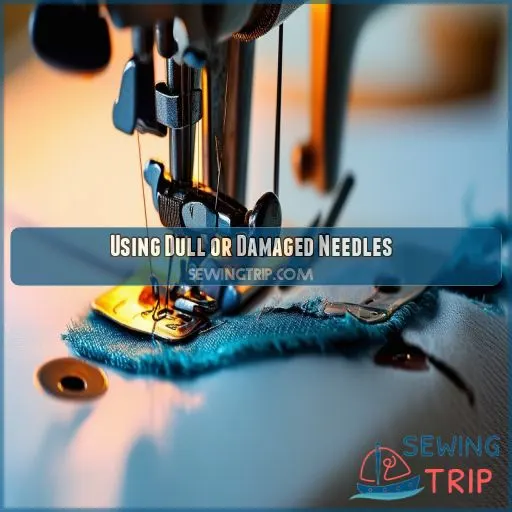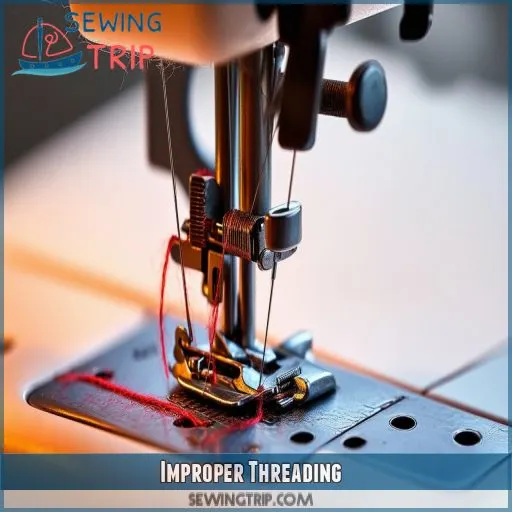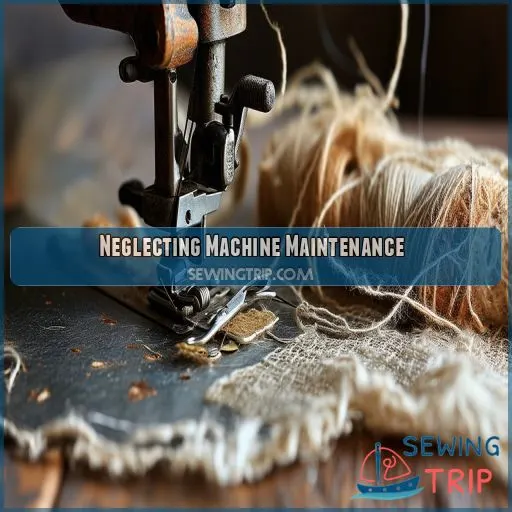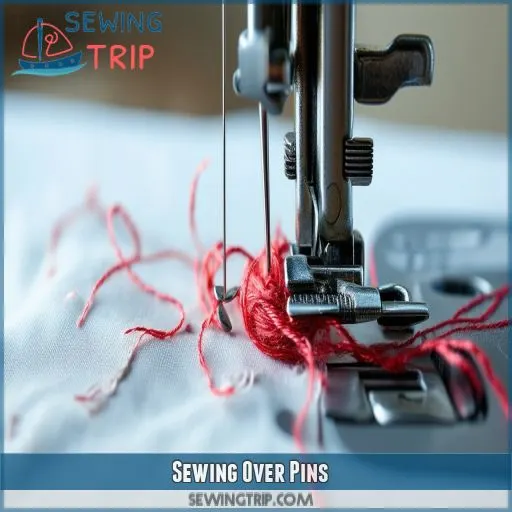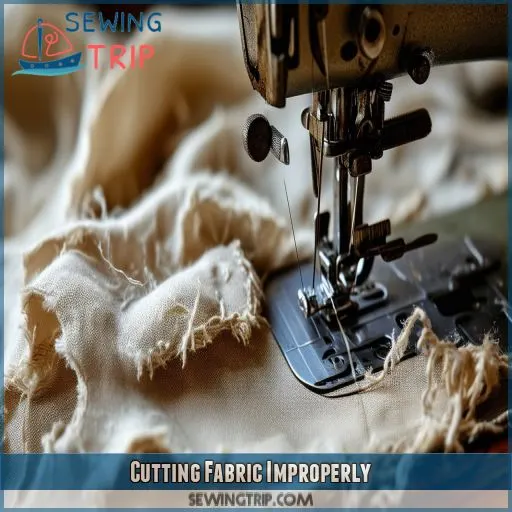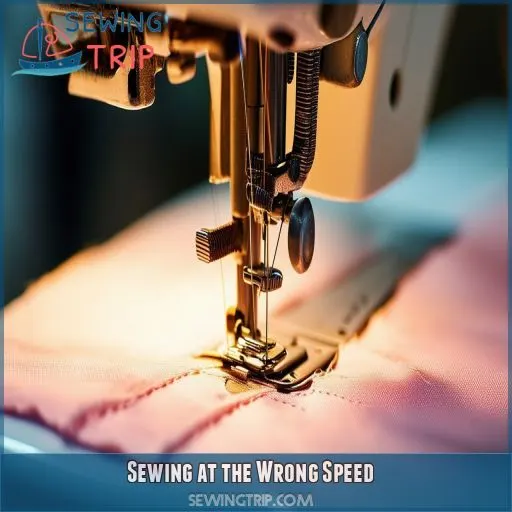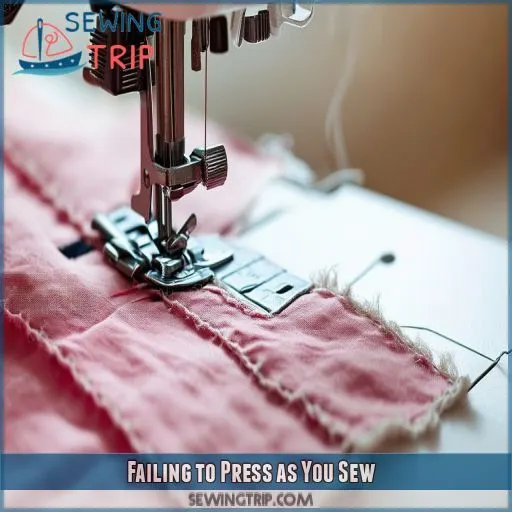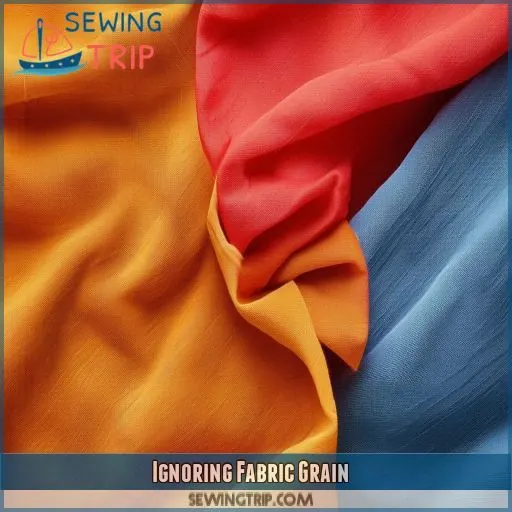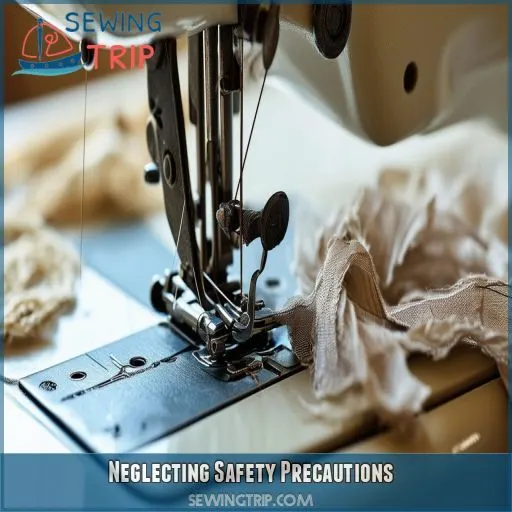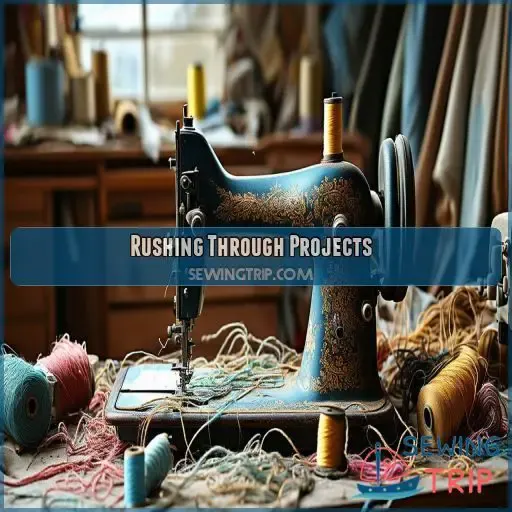This site is supported by our readers. We may earn a commission, at no cost to you, if you purchase through links.
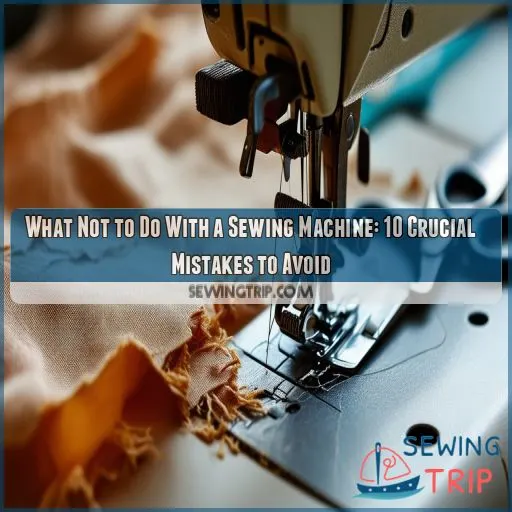
Stay away from dull needles, improper threading, dirty workings, stray pins, and uneven fabric cutting. Be mindful of the right speed and respect the fabric’s design.
These simple steps will help you keep your sewing machine purring along so you can keep creating your gorgeous designs.
There’s more where this came from –ten essential commandments of sewing bliss! So, stay tuned!
Table Of Contents
- Key Takeaways
- What Not to Do With a Sewing Machine?
- Using Dull or Damaged Needles
- Improper Threading
- Neglecting Machine Maintenance
- Sewing Over Pins
- Cutting Fabric Improperly
- Sewing at the Wrong Speed
- Failing to Press as You Sew
- Ignoring Fabric Grain
- Neglecting Safety Precautions
- Rushing Through Projects
- Frequently Asked Questions (FAQs)
- Conclusion
Key Takeaways
- Don’t be a needlehead! Using dull or damaged needles can tear your fabric and leave you with a headache of skipped stitches.
- Threading your machine is like threading a maze – do it wrong and you’ll end up with a tangled mess and a machine that’s throwing a tantrum.
- Stray pins are the sworn enemies of your sewing machine. They’ll break needles and damage your machine faster than you can say "ouch!"
- Don’t be a fabric bully! Cutting fabric improperly can lead to wonky cuts and uneven hems. Remember, measure twice, cut once, and keep your fingers away from the blade.
What Not to Do With a Sewing Machine?
Regarding what to avoid with a sewing machine, there are several critical mistakes to steer clear of, such as using blunt or broken needles, incorrect threading, and ignoring maintenance. Additionally, sewing over pins, cutting fabric inadequately, and rushing through projects can also lead to subpar results and damage to the machine.
Using Dull or Damaged Needles
Don’t make the mistake of sewing with a blunt needle, as it can damage your fabric and produce poor-quality stitches. Using the wrong needle type for your fabric can also lead to problems, so always match your needle to the material you’re working with.
Sewing With a Blunt Needle
When you’re sewing with a blunt needle, you’re asking for trouble. A dull sewing machine needle can wreak havoc on your project and machine. It’s like trying to cut bread with a butter knife – inefficient and potentially damaging. Don’t let a worn-out needle hold you back from achieving sewing mastery.
Here’s what can happen when using a blunt needle:
- Skipped stitches that weaken your seams
- Fabric puckering that ruins your garment’s appearance
- Increased noise and vibration from your machine
- Potential damage to your sewing machine’s timing
Using the Wrong Needle Type for the Fabric
You’re setting yourself up for trouble if you don’t match your needle to your fabric.
Lightweight fabrics need fine needles, while heavier materials require beefier ones.
It’s not just about size, though. The needle’s point shape matters too. Using the wrong type can lead to skipped stitches, fabric damage, or even a broken needle.
Don’t let a mismatch derail your project—choose wisely!
Improper Threading
When threading your sewing machine, it’s essential to follow the correct path and use the appropriate type and weight of thread for your project. Be sure to check your machine’s tension settings, as improper threading or incorrect thread choice can lead to frustrating issues like tangled stitches, puckered fabric, or broken threads.
Not Threading the Machine Correctly
Threading errors can wreak havoc on your sewing machine, causing tension problems and even needle damage. Don’t let your excitement to start sewing lead you astray.
Take your time to thread correctly, from spool to needle. Skipped stitches and machine damage are often the result of careless threading.
Using the Wrong Thread Type or Weight
Choosing the proper thread type and weight is essential for your sewing project’s success. Avoid using weak or low-quality thread that will break under tension.
Align your thread thickness with your fabric weight and sewing machine’s capabilities. Keep in mind, sergers often require different thread than standard machines.
Utilizing thread stands? Verify their compatibility with your setup.
Mastering thread selection empowers you to create professional-looking, durable garments that will withstand the test of time.
Failing to Check the Thread Tension
Don’t overlook thread tension! It’s a common mistake that can lead to a host of sewing woes.
Uneven stitches, thread breakage, and skipped stitches are telltale signs of tension troubles.
Before you start your project, always test your machine’s tension on a scrap of fabric. Adjust the dial if needed, and remember that different fabrics may require different settings.
Master this, and you’ll attain the key to professional-looking seams.
Neglecting Machine Maintenance
You’re making a big mistake if you neglect regular maintenance of your sewing machine. Failing to clean it often, skipping necessary oiling, and not replacing needles frequently enough can lead to poor performance and potentially costly repairs down the line.
Not Cleaning the Machine Regularly
Don’t neglect your sewing machine’s cleaning routine. Dust, lint, and thread debris can wreak havoc on its performance.
Establish a regular cleaning schedule to keep your machine in top shape. Use appropriate cleaning accessories and solutions to remove buildup from the bobbin area, feed dogs, and tension discs.
A clean machine ensures quality stitches and longevity. Remember, what not to do with a sewing machine includes ignoring its maintenance needs.
Failing to Oil the Machine as Needed
- Apply oil sparingly to designated spots
- Use only sewing machine-specific oil
- Follow manufacturer’s guidelines for frequency
- Store oil in a cool, dry place
- Master proper oiling techniques for longevity
Not Replacing the Needle Often Enough
Regarding needle lifespan, be mindful that needles deteriorate over time, potentially impairing the quality of your stitch work. It’s imperative to select the appropriate needle for the task at hand to prevent breakage and ensure optimal stitch quality. Generally, a higher number denotes a finer needle.
Needle sharpness and lubrication are also key factors to bear in mind. Although needle lubrication is uncommon, needle sharpness is paramount, as it governs how easily the needle pierces the fabric and impacts the overall sewing experience.
Sewing Over Pins
You should always remove pins from your fabric before sewing over them, as leaving pins in can severely damage your machine’s needle and internal mechanisms. Sewing over pins not only risks breaking your needle but can also cause metal shards to fly, potentially injuring you or damaging your sewing machine’s delicate parts.
Leaving Pins in the Fabric as You Sew
Just as neglecting machine maintenance can lead to issues, leaving pins in your fabric while sewing is another common mistake. It’s tempting to rush through your project, but this habit can cause serious problems. Here’s why you should avoid sewing over pins**:
- Increases risk of needle breakage
- Can damage your machine’s delicate parts
- May cause fabric puckering or distortion
- Slows down your sewing process
- Creates potential safety hazards
Proper pin storage and removal are key to maintaining your machine and achieving professional results.
Sewing Over Pins Can Damage the Needle and Machine
Sewing over pins is a risky move that can lead to serious consequences. You’re not just risking needle breakage; you’re inviting potential machine damage and fabric snagging. The repair costs can add up quickly, not to mention the safety hazards involved. Let’s break down the risks:
| Risk | Consequence | Prevention |
|---|---|---|
| Needle Breakage | Flying shards | Remove pins before sewing |
| Machine Damage | Costly repairs | Use alternative methods |
| Fabric Snagging | Ruined projects | Pin perpendicular to seam |
| Safety Hazards | Personal injury | Practice safe techniques |
| Time Wasted | Delays in project finish | Plan ahead, work carefully |
Cutting Fabric Improperly
When cutting fabric for your sewing project, it’s imperative to use a flat, stable surface and sharp, well-maintained scissors or rotary cutters. You should also make certain that the presser foot is raised before cutting fabric, as attempting to cut with it down can damage your machine and result in uneven cuts.
Not Cutting on a Flat, Stable Surface
Just as sewing over pins can damage your machine, cutting fabric improperly can ruin your entire project.
Don’t skimp on your cutting area! You need a flat, stable surface to guarantee precise cuts.
Set up a dedicated space with ample room for your fabric, sharp scissors, and rotary cutter. A proper pressing surface nearby will help maintain fabric orientation.
Using Dull or Damaged Scissors or Rotary Cutter
Now that you’ve got a flat surface, let’s talk about your cutting tools. Using dull or damaged scissors can turn your fabric into a frayed mess. You’ll struggle to achieve clean cuts, leading to imprecise pieces and frustration. To keep your cutting game sharp:
- Invest in quality fabric scissors
- Store them properly to avoid damage
- Sharpen regularly with a professional sharpener
- Use only for fabric to maintain their edge
Don’t let dull tools hold you back from mastering your craft!
Cutting Fabric With the Presser Foot Down
When cutting fabric, always raise your presser foot. Leaving it down can lead to disastrous results. You’ll struggle with accuracy, potentially damage your machine, and risk uneven seam allowances. Here’s a quick guide to proper cutting techniques:
| Technique | Do | Don’t |
|---|---|---|
| Using rotary cutter | On cutting mat | On machine bed |
| Cutting multiple layers | Use pattern weights | Use pins near blade |
| Thread fraying | Use pinking shears | Cut with dull scissors |
| Fabric slipping | Use fabric clips | Hold with your teeth |
Mastering these skills will elevate your sewing game, giving you the power to create flawless projects.
Sewing at the Wrong Speed
When using your sewing machine, it’s essential to maintain the appropriate speed for your fabric type. Sewing too quickly can lead to mistakes and puckering, especially with delicate fabrics, while sewing too slowly might result in uneven stitches and tension issues.
Sewing Too Fast for the Fabric Type
After ensuring you’ve cut your fabric properly, it’s imperative to think about your sewing speed. Rushing through your project by sewing too fast can lead to disasters, especially with delicate fabrics.
Different fabric types require varying speeds for ideal results. Adjust your machine’s tension and stitch length accordingly.
Sewing Too Slowly Can Cause Uneven Stitches
While sewing slowly might seem cautious, it can actually lead to uneven stitches. You’ll need to find the right balance for each fabric type. Slow sewing can cause the feed dogs to struggle, resulting in inconsistent seam quality. To improve your technique:
- Adjust your presser foot pressure for better fabric control
- Practice on scrap fabric to find the ideal speed
- Maintain a steady rhythm, neither too fast nor too slow
- Consider using a seam guide for straighter lines
- Experiment with different stitch lengths to complement your speed
Failing to Press as You Sew
Failing to press as you sew can lead to bulky seams, uneven edges, and a less polished finish. Pressing seams open or to one side creates a more professional and refined look, while pressing darts, pleats, and other details enhances the garment’s shape and structure.
Not Pressing Seams Open or to One Side
While speed matters, precision is equally essential.
Don’t overlook pressing seams as you sew. Failing to press open or to one side can result in bulky, unprofessional-looking garments.
Use the right pressing tools for your fabric weight and adjust your iron temperature accordingly.
A sturdy pressing surface and proper seam allowance management will elevate your sewing projects, giving you that polished, professional look you’re aiming for.
Not Pressing Darts, Pleats, and Other Details
Don’t overlook the power of pressing darts, pleats, and other details. It’s not just about flattening fabric; it’s about shaping your garment.
You’ll be amazed at how pressing seams, hems, and intricate details can transform your project. Skipping this step can leave your creation looking homemade rather than professional.
Take the time to press as you go, and you’ll master the art of polished sewing.
Ignoring Fabric Grain
When you cut fabric off-grain or sew seams that aren’t parallel to the grain, you’re setting yourself up for a poorly fitting garment. Ignoring fabric grain can lead to twisted seams, uneven hems, and distorted patterns, so always take care to align your pattern pieces correctly with the fabric’s grain lines.
Cutting Fabric Off-grain
When cutting fabric, you’re playing with fire if you ignore the grain. It’s not just a fancy term; it’s your roadmap to success.
Using your rotary cutter on a cutting mat, verify that you’re following the fabric’s natural direction. Off-grain cuts can lead to wonky garments that twist and pull.
Sewing Seams That Are Not Parallel to the Grain
Once you’ve cut your fabric on-grain, it’s imperative to preserve that accuracy when sewing. Disregarding fabric grain while stitching can lead to disastrous results. To verify your seams align perfectly with the fabric’s warp and weft:
- Use fabric grain lines as a guide for seam placement
- Align pattern pieces carefully before pinning
- Double-check seam alignment before stitching
Neglecting Safety Precautions
When operating a sewing machine, it’s paramount to prioritize safety by keeping your fingers away from the needle, using the appropriate presser foot for each task, and wearing glasses for close-up work if necessary. These precautions guarantee your protection from potential injuries and also ensure that you’re using the machine correctly and efficiently, leading to better sewing results.
Not Keeping Fingers Away From the Needle
While focusing on fabric grain is essential, let’s not disregard your fingers! Keeping them away from the needle is paramount. Your safety should always be your top priority. Here’s a quick guide to help you prevent painful mishaps:
| Danger Zone | Safety Measure | Benefit |
|---|---|---|
| Needle Area | Use needle guards | Prevents accidental pricks |
| Fabric Edges | Use safety pins | Secures fabric safely |
| Work Surface | Proper hand positioning | Maintains control |
| Machine | Minimize distractions | Enhances focus |
| Overall | Stay vigilant | Ensures smooth sewing |
Not Using the Proper Presser Foot
Using the wrong presser foot can turn your sewing project into a disaster. Each foot serves a specific purpose, and using the incorrect one can damage your fabric or machine. Don’t let presser foot selection become your Achilles’ heel. Master this skill, and you’ll discover a world of sewing possibilities. Here’s what you need to know:
- Choose the right presser foot for your fabric type
- Confirm proper presser foot attachment to avoid mishaps
- Adjust presser foot pressure for best results
- Check presser foot compatibility with your machine model
- Familiarize yourself with various presser foot types and their uses
Not Wearing Glasses for Close-up Work
As you focus on using the proper presser foot, don’t forget to prioritize your own safety. Not wearing glasses for close-up work can lead to eye strain and poor visibility, especially in areas with poor lighting. Invest in safety glasses or magnification tools to ensure you’re working comfortably and accurately, maintaining proper posture to avoid fatigue.
Rushing Through Projects
Rushing through sewing projects can lead to mistakes and poor-quality garments. Take breaks when you need them to stay focused and avoid errors. Double-check your measurements and markings to guarantee accuracy and prevent costly mistakes.
Not Taking Breaks When Needed
Don’t let fatigue set in! Take regular breaks** to rest your eyes, stretch, and recharge. Poor posture and ergonomics can lead to long-term health issues. Stop sewing when you’re tired, and take a break every 20-30 minutes. Your body (and project) will thank you. Remember, a fresh mind and healthy body are key to mastering your sewing machine.
Not Double-checking Measurements and Markings
As you rush through your project, remember to double-check your measurements and markings. Misreading measurements or ignoring markings can lead to inaccurate cutting, fabric distortion, and the need for tedious pattern adjustments. Don’t let haste make waste!
- Fabric distortion that’s impossible to fix
- Hours of re-sewing due to inaccurate cutting
- Frustration and disappointment in your finished project
- Wasted fabric and supplies due to preventable mistakes
Not Making a Test Garment or Toile
Don’t skip the critical step of making a test garment or toile. This inexpensive practice piece allows you to assess the fit, make pattern adjustments, and troubleshoot any issues before cutting into your final fabric. Investing the time upfront can save you from costly mistakes down the line. Take the time to do it right.
| Toile vs. Muslin | Choosing Fabric for Toile | Benefits of Using a Toile |
|---|---|---|
| Toile is a test garment made from inexpensive fabric, while muslin is a specific type of cotton fabric. | Use a similar weight and drape to your final fabric for the most accurate fit assessment. | Identify fit issues, make pattern adjustments, and troubleshoot construction before cutting into your final fabric. |
| Toile for Pattern Adjustments | Toile for Fit Assessment | |
| Adjust the pattern based on the toile to ensure a perfect fit in the final garment. | Evaluate the overall fit, silhouette, and ease of movement in the toile before sewing the final piece. |
Frequently Asked Questions (FAQs)
What are three important rules when using a sewing machine?
When using a sewing machine, remember to always turn the hand wheel in your direction, never leave thread dangling, and store bobbins responsibly to avoid damaging your machine and guarantee smooth, efficient sewing.
What precautions should be taken while using a sewing machine?
When using a sewing machine, you should avoid unattended threads, store threads and bobbins responsibly, and keep your workspace clear to prevent thread tangles, machine damage, and motor burnout.
What are some sewing mistakes?
You’re prone to sewing mistakes when you hold pins in your mouth, don’t wash fabric beforehand, or use poor-quality thread, leading to issues like needle breaks, fabric damage, and wasted time.
What are 10 sewing safety rules?
Always keep your fingers away from the needle, never sew over pins, and never leave the machine unattended. Maintain good posture, take breaks, and keep your work area clean. Invest in quality tools and regularly maintain your machine for safe, enjoyable sewing.
Why is my sewing machine not working?
You’re wondering why your sewing machine isn’t working? Check if you’re using a blunt needle, wrong thread, or incorrect presser foot. Make sure you’re using quality materials and following proper techniques to avoid common issues that can cause machine malfunction.
How to avoid sewing problems?
To avoid sewing problems, guarantee you use the right needle and thread for your fabric, maintain your machine regularly, and follow proper sewing techniques. Additionally, store thread and bobbins responsibly and keep your workspace organized.
How do you fix a sewing machine that won’t sew?
You fix a sewing machine that won’t sew by checking for thread issues, ensuring proper needle usage, and maintaining the machine regularly, as well as addressing potential hand wheel and presser foot problems.
What are the most common sewing machine problems?
The most common sewing machine problems are thread bunching, skipped stitches, fabric puckering, and needle breakage. Proper threading, tension adjustment, and regular maintenance can prevent these issues and keep your machine running smoothly.
Can a sewing machine problem be fixed?
Sewing machine problems can often be fixed with a little know-how. Just like a car, regular maintenance and troubleshooting can keep your machine running smoothly. Don’t let a hiccup stop your creative flow – get to the root of the issue and sew on!
How to use a sewing machine safely?
To use a sewing machine safely, you should maintain good hygiene, perform regular machine maintenance, and follow proper sewing techniques, including using the right needle and thread, and keeping your workspace organized and clutter-free.
Can I use my sewing machine in a humid basement?
Sewing in a humid basement can cause issues with your machine. Moisture may attract dust and lint, clogging mechanisms. Avoid sewing there if possible. If needed, clean your machine more frequently to prevent problems.
How often should I clean the sewing machines bobbin area?
Regularly cleaning your sewing machine’s bobbin area is essential to maintain ideal performance. Aim to clean it after every project or at least once a month. Neglecting this task can lead to thread jams and poor stitch quality.
Is it okay to yank the fabric while sewing a seam?
Don’t yank the fabric while sewing a seam, as it can cause uneven stitches, fabric distortion, and even break your needle. Instead, gently guide the fabric, maintaining a steady pace and consistent tension for professional-looking results.
Can I use a sewing machine on a wobbly or uneven table?
Avoid using a wobbly or uneven table for your sewing machine. It can cause alignment issues, thread tension problems, and even damage to your machine. Always use a sturdy, level surface for good performance and safety.
Should I sew through multiple layers of fabric at once?
Don’t attempt to sew through multiple layers of fabric at once, as it can put excessive strain on your machine, leading to thread breaks, jammed needles, and even machine damage – a recipe for sewing disaster!
Conclusion
Spare your sewing machine the agony of:
- Dull needles
- Improper threading
- Stray pins
By avoiding these common mistakes, you’ll prevent:
- Fabric tears
- Skipped stitches
- Unwanted noise
Now, go ahead and sew with confidence, knowing you’ve dodged the pitfalls of sewing machine sabotage.

